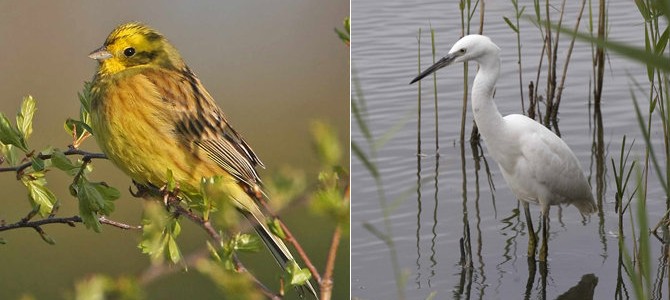The Ups and Downs of Britain’s Bird Populations
by

Yellowhammer: Jill Pakenham/BTO LIttle Egret: John Harding/BTO
The ‘little bit of bread and no cheese’ of the Yellowhammer is a sound that is disappearing from our countryside. Forty years ago the species could be heard singing in almost every village of Britain and Ireland, but Yellowhammers are now missing from large swathes of Ireland, western Scotland, southern Wales and northern England, representing a 32% contraction for this formerly widespread breeding bird.
On the other hand, forty years ago the Little Egret was very much a bird of the Mediterranean, but in 1996 this small white heron bred here for the first time. Since then it has increased its range in Britain by a whopping 16,350% and has become a familiar bird for many and one that our children will grow-up with and associate with British wetlands. They’ll assume that it was always there.
These are just two of the findings that have surprised experts following one of the most ambitious volunteer surveys ever undertaken. The project was to map all birds in both winter and the breeding season, from every part of Britain and Ireland. The results have been published this week in a Bird Atlas 2007–11 made up of records submitted to the British Trust for Ornithology (BTO) by over 40,000 volunteers.
“Bird Atlas 2007-11 is the amazing product from the efforts of tens of thousands of wonderful volunteer birders who care passionately that their observations help birds. Their information, collected over four years, presents a richly detailed view of change brought to life in this beautiful book,” said Andy Clements, BTO Director.
The Atlas reveals that for nearly all birds there has been a shift in where they live. Every species has a story to tell.
“As the maps started to come together it was astonishing just how much had changed. There were stories that we knew, such as the disappearance of Tree Sparrows and the spread of Egyptian Geese, but why are we losing specialist species such as Willow Tit, now virtually extinct in southeast England, and what’s driving the spread of Nuthatches?” asked Dawn Balmer, Atlas Coordinator.
The Atlas shows over three quarters of the species spending the winter months in Britain are now found in more areas than three decades ago, but also that a concerning 8% of species are now found in fewer areas.
The Green Woodpecker exemplifies the complexity of the changes seen, becoming more common in eastern England and spreading northwards into parts of eastern Scotland, but beginning to disappear from western Wales, an area that is also losing its Lapwings, Kestrels and Starlings.
Commenting BTO Senior Research Ecologist Simon Gillings said, “Conservation scientists have been desperate for a new atlas. Its comprehensive coverage of all areas and all species gives us the depth of information we need to learn from our recent conservation successes, and plan for the challenges of tomorrow,”

